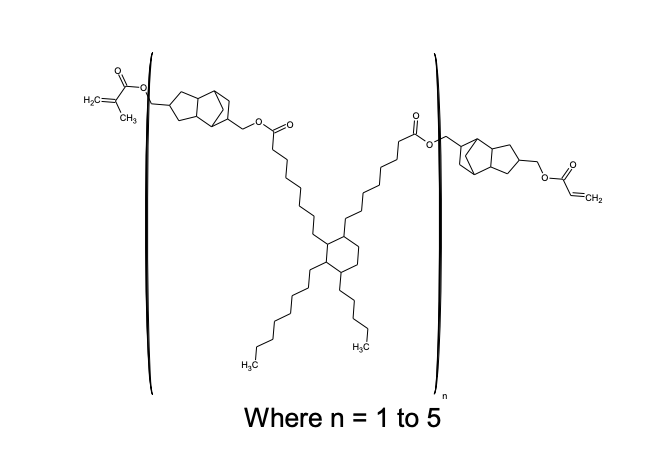PEAM-1044 Low warpage Polyester Acrylate/Methacrylate
- Thermally stable
- Low warpage
- High adhesion to various substrates
Product Description
PEAM-1044 is a polyester acrylate/methacrylate that exhibits excellent adhesion, low warpage, and hydrophobicity. The oligomer has very high thermal stability and low volatility. It can be used as a base resin in a formulation or an additive. It is dark amber-colored, something that needs to be considered for light cure application.
PEAM-1044 is recommended for use as a base resin. It has excellent adhesion with low stress due to its high Tg DCPD units. The oligomer has good solubility in both aliphatic and aromatic resins. Exceptionally low warpage can be achieved with the addition of polybutadiene type resins. Compared to what most people use (epoxies) the PEAM-1044 is composed of large, low functionality, oligomers instead of small, highly cross-linked monomers. That's why it is common to use PEAM 645 which is more akin to epoxies or a combination of both.
Technical Specifications
| General Properties | |
| Appearance Appearance Appearance at room temperature. | Amber Liquid |
| Thermal Properties | |
| Glass Transition Temperature (Tg) Glass Transition Temperature (Tg) The glass transition temperature for organic adhesives is a temperature region where the polymers change from glassy and brittle to soft and rubbery. Increasing the temperature further continues the softening process as the viscosity drops too. Temperatures between the glass transition temperature and below the decomposition point of the adhesive are the best region for bonding. The glass-transition temperature Tg of a material characterizes the range of temperatures over which this glass transition occurs. | -25 °C |
| Weight Loss @ 300°C | 3 % |
| Physical Properties | |
| Viscosity Viscosity Viscosity is a measurement of a fluid’s resistance to flow. Viscosity is commonly measured in centiPoise (cP). One cP is defined as the viscosity of water and all other viscosities are derived from this base. MPa is another common unit with a 1:1 conversion to cP. A product like honey would have a much higher viscosity -around 10,000 cPs- compared to water. As a result, honey would flow much slower out of a tipped glass than water would. The viscosity of a material can be decreased with an increase in temperature in order to better suit an application | 4,500 mPa.s |



